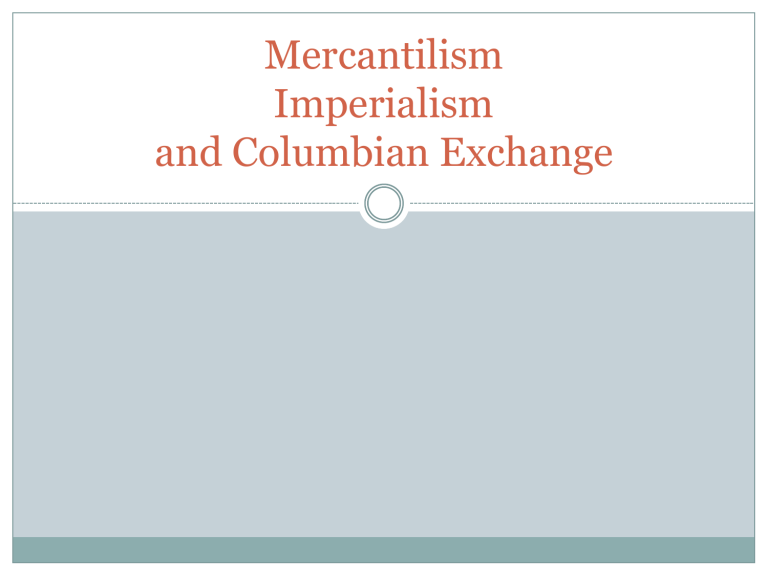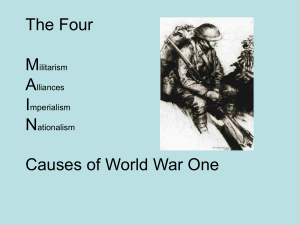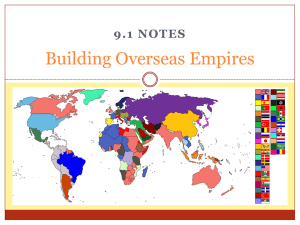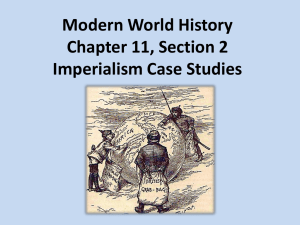Mercantilism and Imperialism - ReneeASD

Mercantilism
Imperialism and Columbian Exchange
Mercantilism
Mercantilism – an economic policy where nations wanted to increase their wealth and power by obtaining large amounts of gold and silver and by selling more goods than they bought.
Goal of Mercantilism
Under Mercantilism, a nation could increase its wealth in 2 ways
1.
2.
Obtain as much gold and silver as possible
Establish a favorable balance of trade (sell more goods than they bought)
The main goal of mercantilism was to become self-
sufficient, not depending on other countries for goods.
Mercantilism and Europe
Through exploration, Europe was able to find new lands which contained raw materials they did not have.
By colonization – setting up and controlling land –
Europe was able to access these materials.
Imports
They could import gold, silver, and raw materials from the colony to sell in their home markets. Merchants were able to buy these items and sell them at a profit to make money.
Exports
Merchants could export European products to the colony to make money.
More Colonies
As colonies developed, merchants became wealthy.
Their wealth led to more exploration to set up more colonies.
Imperialism
Imperialism – a policy in which a strong nation seeks to dominate other countries politically, economically, or socially.
Goal of Imperialism
Under Imperialism, a nation controls another nation or land.
The main goal of imperialism is to grow the home country and its ideas by controlling a weaker nation or land.
Imperialism and Europe
Europe practiced imperialism with the colonies because they
1. Controlled all aspects of colony life
2. Funded exploration by providing ships, materials, supplies and other needs
Imperialism and the Colonies
The colonists were involved in imperialism because they:
1. Were forced to follow the same laws as the home country
2. Provided economic gain for the home country.
3. Imported silver, gold and raw materials
4. Bought supplies from the home country
Mercantilism and Imperialism
Mercantilism and Imperialism led to more exploration and colonization.
As colonies were established, the home country exported materials to the colony which were bought at a profit by the colonists.
As the colonies discovered new raw materials they were imported to the home country and sold by merchants at a profit.
As merchants earned more profit, they re-invested part of their funds into more exploration and more colonization hoping to gain even more profit.
Colonization and Exploration
Success of Explorers
To fund explorations, many merchants could give SOME money to the trip. This was called a joint-stock company.
If the trip was successful and a new colony was established, everyone who put in some money shared in the profits.
If the trip was unsuccessful, everyone lost only that portion of the money they contributed.
Not all trips were successful, many died trying to find new lands and establish colonies.
Joint Stock Company
Joint Stock Company
Donald Adams, Benjamin Baker,
David Copper, Andrew Fisher,
Jacob Hunter, Lewis James,
John Marks, Luke Robinson,
Terry Sanders, William Wiley
Each member gave $100 toward each colony attempt.
Total $300 invested per person.
New Colony
A
SUCCESSFUL
Each member earned money on this colony!
New Colony
B
UNSUCCESSFUL
Each member lost
$100 on this colony!
New Colony
C
UNSUCCESSFUL
Each member lost
$100 on this colony!
The Columbian Exchange
As colonies were established, Europe and the other home countries imported (brought IN) goods from the Americas: tomatoes, squash, pineapples, tobacco, cocoa beans, turkeys, corn, and potatoes.
The home country exported (sent OUT) goods to the
Americas horses, cattle, sheep, pigs, wheat, rice, barley, and oats.
They also exported (sent OUT) to the Americas diseases which were deadly for the Native Americans including small pox and measles. These diseases, which were common in
Europe, were not common in the Americas. They killed millions of Native Americans who were not able to treat the diseases .
The Columbian Exchange
The Columbian Exchange
Columbian Exchange Passage
The crucial factor was not people, plants, or animals, but germs. The history of the United States begins with
Virginia and Massachusetts, and their histories begin with epidemics of unidentified diseases. At the time of the
Virginia colony at Roanoke in the 1580s the nearby Native Americans “began to die quickly. The disease was so strange that they neither knew what it was, nor how to cure it….” 1 When the Pilgrims settled at Plymouth,
Massachusetts in 1620, they did so in a village and on a coast nearly cleared of Native Americans by a recent epidemic. Thousands had "died in a great plague not long since; and pity it was and is to see so many goodly fields, and so well seated, without man to dress the same." 2
Smallpox was the worst and the most spectacular of the infectious diseases mowing down the Native Americans.
The first recorded pandemic of that disease in British North America detonated among the Algonquin of
Massachusetts in the early 1630s: William Bradford of Plymouth Plantation wrote that the victims “fell down so generally of this disease as they were in the end not able to help one another, no not to make a fire nor fetch a little water to drink, nor any to bury the dead.”
In 1738 alone the epidemic destroyed half the Cherokee; in 1759 nearly half the Catawbas; in the first years of the next century two-thirds of the Omahas and perhaps half the entire population between the Missouri River and
New Mexico; in 1837-38 nearly every last one of the Mandans and perhaps half the people of the high plains.
Even if we add all the Old World deaths blamed on American diseases together the total is insignificant compared to Native American losses to smallpox alone.
Based on the passage above, circle the correct answer to the following questions.
1. What is the main idea of this passage? A. Explorers B. Diseases
2. What had the worst impact on the Native Americans? A. People
C. Colonies
B. Plants C. Germs
3. What was the worst disease for the Native Americans? A. Smallpox B. Catawbas C. Pandemic
4. Which Native American tribe was totally destroyed? A. Cherokee B. Omahas C. Mandans
5. According to the passage, “thousands had died in a plague not long since” what was the “pity”?
A. The deaths of the Native Americans B. The land that was not being farmed C. The new plants and animals
Fill in the missing information
Plants Animals
______
Diseases
Colonists &
Imperialsim
Bought supplies from the home country
Obtain large amounts of gold
Obtain large amounts of silver
Establish a favorable balance of trade
Strong country dominates a weak country
Economically
Strong country dominates a weak country Socially
Strong country dominates a weak country
Politically
Timeline – based on the timeline to the left, answer the questions on the right.
Aug 3, 1492
Columbus Sails
Aug 12, 1492
Columbus Discovers the New World
Nov 8, 1519
Cortés Arrives
Jul 1, 1520
Aztec Attack Spanish
Jul 8, 1520
Aztec Smallpox
Aug 13, 1521
Aztecs Surrender
1525
Inca Smallpox
Nov 16, 1532
Pizarro Captures Incas
Mar 23, 1534
Spanish Conquest
Jun 1, 1539
De Soto Expedition
May 21, 1542
De Soto Dies
1682
La Salle Canoes down Mississippi
1700
Comanche Utilize Horses
1. Which happened first?
a. Aztec attack Spanish b. DeSoto Dies c. Cortes Arrives
2. Who came last?
a. Cortes b. Columbus c. DeSoto
3. Which happened to the Aztecs last?
a. Spanish attack b. Smallpox c. Surrender
4. Which two things happened in the same year?
a. Aztec attack Spanish and get Smallpox b. Columbus sails and discovers the New World c. Inca get smallpox and Pizarro conquers them
5. What river did LaSalle canoe down?___________________
6. In what year did Columbus set sail?___________________
7. Who did Pizarro capture?
a. Aztecs b. Comanche c. Incas
8. How many years did DeSoto explore before he died?
a. 2 years b. 3 years c. 4 years
9. What year did the Comanche begin to use horses?___________
10. How many years did the Aztecs fight the Spanish?
a. 1 year b. 20 years c. 100 years









